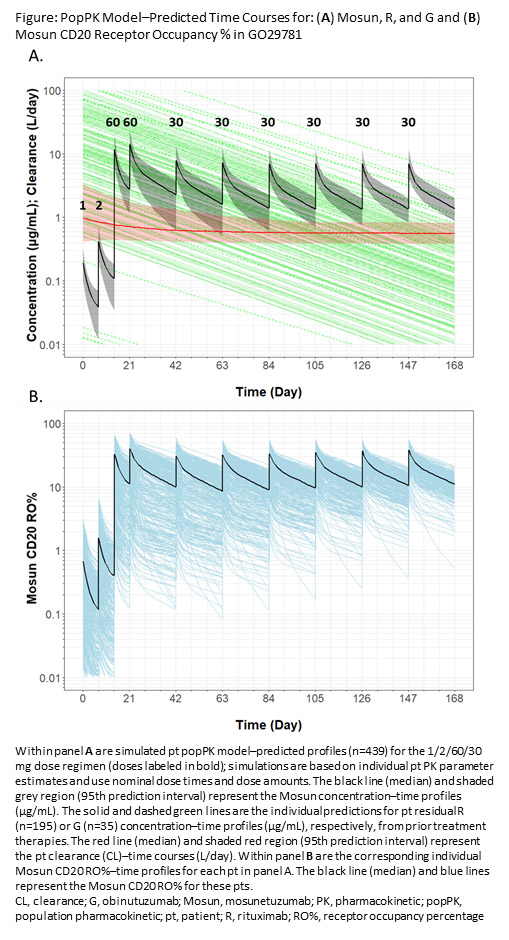Introduction: Mosunetuzumab (Mosun) is a CD20xCD3 T-cell engaging bispecific antibody that redirects T cells to eliminate malignant B cells. Clinical data from GO29781 (NCT02500407), a Phase I/II, open-label, multicenter dose-escalation and expansion study of Mosun in pts with relapsed or refractory (R/R) non-Hodgkin lymphoma (NHL), was used to develop a population pharmacokinetic (popPK) model describing Mosun concentration-time data. Prior to initiation of Mosun, many patients had circulating levels of other anti-CD20 drugs (e.g. rituximab (R) or obinutuzumab (G)) from prior treatment. In order to elucidate exposure-response (ER) relationships in the presence of these competitors, CD20 binding and R/G pharmacokinetics were incorporated into the popPK model to calculate the Mosun CD20 receptor occupancy percentage (RO%) over time.
Methods: Mosun PK data were available in 439 pts with indolent or aggressive R/R NHL who received either Mosun fixed dosing (n= 32; 0.05-2.8mg every 3 weeks (q3w)) or Cycle 1 step-up dosing (n=407, 0.4/1.0/2.8 - 1/2/60/30mg). The popPK model was developed using NONMEM® software (v7.4.3), with a clinical cut-off date of December 4, 2020. Clinically relevant covariates were investigated for their potential to explain Mosun PK variability. The Mosun CD20 RO% time course for each pt was derived by integrating the Mosun, R, and G model predicted concentration-time courses and their respective CD20 affinities (Kds) into the popPK model. R and G concentration-time courses were predicted by the model using their baseline values and published half-lives, and binding kinetics were assumed to be at equilibrium.
PopPK model simulations (n=1000) were done with the final model to establish Mosun concentration ranges for the approved 1/2/60/30 mg dose regimen, given that this regimen was designed to mitigate cytokine release syndrome (CRS) through its step-up Cycle 1 design. Additional popPK model simulations, incorporating Mosun dose delays, were conducted and compared to the 1/2/60/30 mg nominal dose regimen to inform treatment resumption protocols necessary to mitigate CRS.
Results : A two-compartment PK model with time-dependent clearance (CL) best described Mosun PK. Mosun CL decreased from an initial value of 1.08 L/day transitioning to a steady state clearance of 0.584 L/day by Cycle 4 (Figure 1A). Mosun terminal phase half-life at steady state was 16.1 days. Concentrations of R/G were present in 50% of patients prior to Mosun therapy (Figure 1A), and the median predose R/G concentration for these patients was 10.0 µg/mL. Statistically relevant covariates on PK parameters included body weight, albumin, sex, tumor burden, and baseline concentrations of R/G; however, no covariate was deemed to have a clinically relevant impact on PK at the recommended dose of 1/2/60/30mg.
Mosun CD20 RO% was more variable than Mosun PK (Figure 1B), attributed to the large variability in baseline R/G concentrations. The 60mg loading doses increased Mosun CD20 RO% to steady-state ranges by Cycle 1 (Figure 1B), thereby providing Mosun efficacious exposure in the presence of competing residual, transient R/G concentrations from prior treatment therapies (Figure 1A).
From the popPK model simulations, patients with dose delays greater than or equal to 6 weeks had Mosun concentrations that fell below levels after the Day 1 (1mg) and Day 8 (2mg) doses; as such, these pts are instructed to repeat these doses prior to treatment continuation. For Mosun dose delays less than 6 weeks, popPK simulations supported pts either to repeat the last Mosun dose administered, or to continue along with the planned regimen [Lunsumio ® USPI].
Conclusions: Mosun PK was characterized using a two-compartment model with time dependent CL. R/G PK and CD20 binding kinetics were incorporated into the Mosun popPK model to calculate Mosun CD20 RO% over time. The use of two 60mg loading doses enables early achievement of Mosun steady-state target CD20 RO% range, especially benefitting those pts with high levels of precirculating R or G. Simulations with the popPK model supported labeling recommendations for restarting Mosun treatment after dose delays.
Acknowledgments: This study was sponsored by F. Hoffmann-La Roche Ltd / Genentech, Inc
Disclosures
Bender:F. Hoffmann-La Roche Ltd / Genentech, Inc.: Current Employment, Current equity holder in publicly-traded company. Li:F. Hoffmann-La Roche Ltd / Genentech, Inc.: Current Employment, Current equity holder in publicly-traded company. Marchand:F. Hoffmann-La Roche Ltd / Genentech, Inc.: Consultancy. Turner:F. Hoffmann-La Roche Ltd / Genentech, Inc.: Current Employment, Current equity holder in publicly-traded company. Li:F. Hoffmann-La Roche Ltd / Genentech, Inc.: Current Employment, Current equity holder in publicly-traded company. Vadhavkar:F. Hoffmann-La Roche Ltd / Genentech, Inc.: Current Employment, Current equity holder in publicly-traded company. Wang:F. Hoffmann-La Roche Ltd / Genentech, Inc.: Current Employment, Current equity holder in publicly-traded company. Deng:F. Hoffmann-La Roche Ltd / Genentech, Inc.: Consultancy. Lu:F. Hoffmann-La Roche Ltd / Genentech, Inc.: Current Employment, Current equity holder in publicly-traded company. Jin:F. Hoffmann-La Roche Ltd / Genentech, Inc.: Current Employment, Current equity holder in publicly-traded company. Li:F. Hoffmann-La Roche Ltd / Genentech, Inc.: Current Employment, Current equity holder in publicly-traded company. Yin:F. Hoffmann-La Roche Ltd / Genentech, Inc.: Current Employment, Current equity holder in publicly-traded company, Patents & Royalties. Wei:F. Hoffmann-La Roche Ltd: Patents & Royalties; Genentech, Inc.: Current Employment; F. Hoffmann-La Roche Ltd: Current equity holder in publicly-traded company. Chanu:F. Hoffmann-La Roche Ltd / Genentech, Inc.: Current Employment, Current equity holder in publicly-traded company.


This feature is available to Subscribers Only
Sign In or Create an Account Close Modal